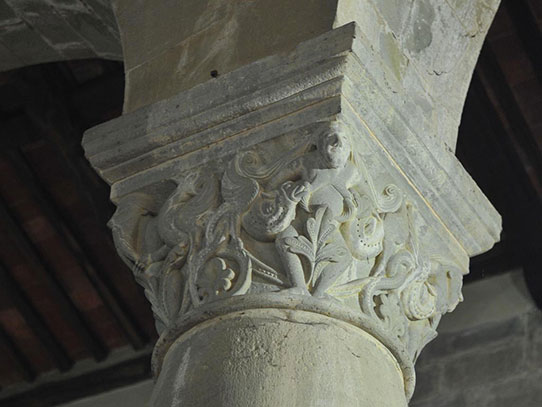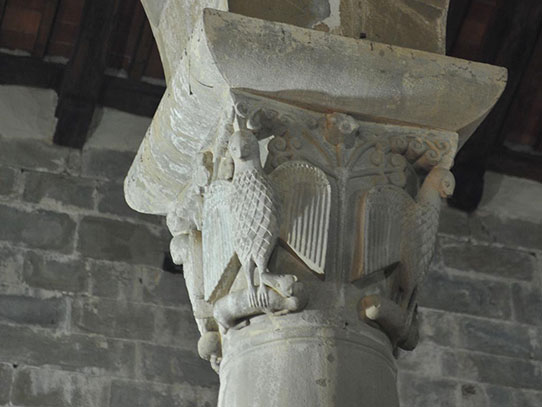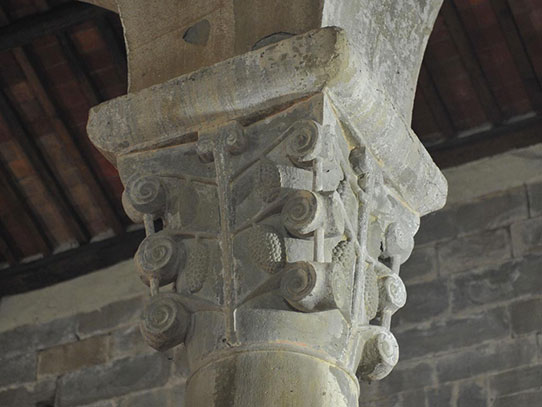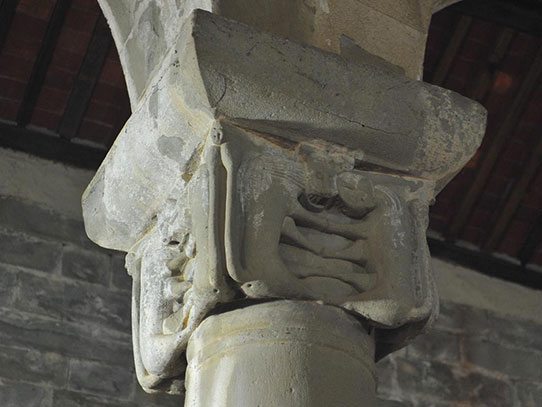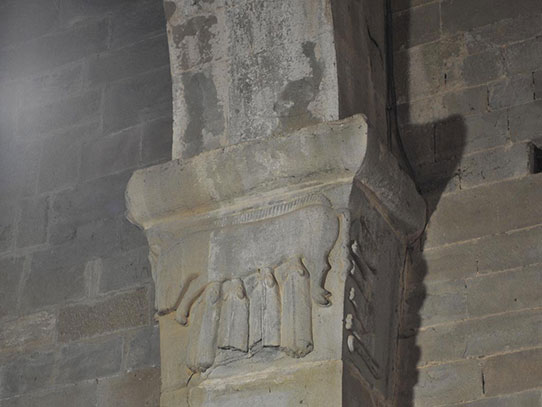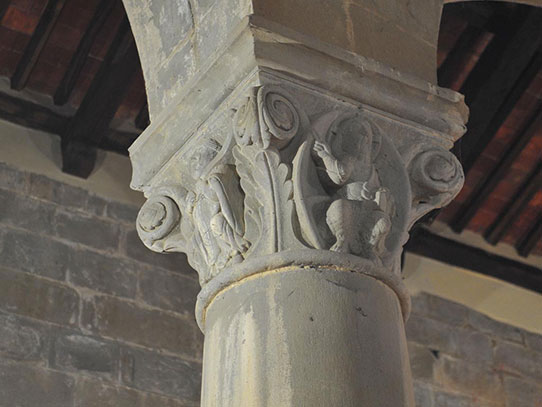THE CAPITALS
Speaking about the capitals means addressing the problem of the church’s date, which is still debated by scholars and not yet definitively resolved. The fact is that in Gropina one can recognize the work of various styles and periods, and one must also consider that the pre-existing early medieval building was not demolished before, but rather during the construction of the Romanesque pieve, so that the numerous worshippers could continue to attend masses for as long as possible while work was in progress.
To illustrate some details of the panorama of specific opinions held we will examine the two most accredited hypotheses: the so-called “classical” one of Mario Salmi (1955 e 1957) and the more recent one of Francesco Gandolfo (2003). Salmi maintained that the construction of the pieve was begun in the first half of the 12th century with the façade and principal nave, continuing in the following decades with the right nave (excluding the capitals) and the beginning of the left nave, the inside walls of the tribune and of the façade, and, before 1191, the realization of the capitals of the right nave. He assigned the completion of the left nave and of the apse to the beginning of the 13th century, ending with the construction of the bell tower around 1233.
For Gandolfo two phases of construction can be recognized: the works were begun around the middle of the 12th century from the apse and continued with the left side of the pieve because the space for the other side was occupied by the Lombard church (this was to result in the misalignment of some of the elements of the façade, as already mentioned, and also of the façade respect to the presbytery), up to the construction of the façade and including the embedded pilaster to the left of the entrance. The apse, the left external wall and the façade were essentially built around the early medieval church, and Gandolfo also attributed to this necessity the slight discrepancies in the positions of the columns of the right and left naves, which do not face each other exactly, whereas the first pair in front of the apse, beyond the area of the Lombard church, are aligned. In his view, this also proves that the Romanesque construction began with the apse, and not with the façade. The second phase of work was begun after the demolition of the pre-existing church, and proceeded until the pieve was completed. He thinks that the passage from the first to the second phase of work occurred between the second and thirds pairs of columns, for stylistic reasons to be discussed below.
It is true that the construction of a church generally begins with the apse and ends with the façade, and the natural advances in scholarship helps in the formulation of more detailed hypotheses, but the problem of the attribution of the capitals to the stages of builders working on the pieve di Gropina is hard for art historians to solve, as there is no documentary evidence. This applies also to the interpretation of each capital and of the possibility of a unified plan, which was often totally lacking in the Romanesque churches, where scenes from the Old and New Testaments were combined with depictions of the real and imaginary world of flora and fauna, trades, symbols, or even, as in the cloister of the abbey of Moissac (southern France), with relics of saints enclosed in the capitals in order to lend the cloister greater significance as a place of repose and meditation. Where a plan existed, often it’s theme was the salvation of the soul: medieval men, with the exception of ecclesiastics, intellectuals and few others, could neither read nor write, and nevertheless were intensely permeated by an apocalyptic vision of religion; their lives, to a large extent, were passed in fear of sin, of a demonic presence and of eternal damnation, whereas in the Paleo-Christian period the defunct were often depicted in Paradise, represented as a garden, or even seated at the eucharistic banquet, among images related to the resurrection. The arrival of the year 1000 marked a throwback to primitive fears. Apocalyptic texts spread among all social classes. The Apocalypse and its terrifying visions became a part of the medieval figurative repertory, with anguishing warnings: "here you see the time, but you don’t know your time”, was written alongside many clocks on public towers (as for example in Castelfranco di Sopra, not far from Gropina); and Masaccio, in his Trinità in Santa Maria Novella in Florence, has the skeleton say "I was once that which you are, and that which I am, you will also be". Famines, wars, lack of hygiene, and primitive medicine all made life highly precarious, so one had to be vigilant to avoid being ambushed by evil and, in case of sudden death, risking perdition of one’s soul. Churches were decorated by sculpted capitals, frescoes, mosaics, and figures in stone to guard the entrances, while priests spoke of salvation through the Word of God from the pulpits: thus the places of Christian worship became stone bibles, sacred books understandable by anyone, because a medieval man, even if he could not read, knew well the symbolic meaning of each representation, that escapes us today.
Symbols were explained in encyclopedic collections, generically called Bestiaries, much in vogue in the 12th century, and even more so in the 13th, but deriving from much earlier periods. The first of these was the Physiologus (that is, the study of nature), from circa 140 to 410 in Alexandria of Egypt, then a leading center of civilization and culture, written in Greek by an unknown author perhaps with gnostic religious views. The Physiologus contains the symbolic description of animals, plants and stones with reference to the Sacred Scriptures presented as allegories of celestial realities or of various types of human behavior. Most of the medieval bestiaries were inspired by this work, and also some erotic bestiaries, in a tradition that was to continue until around the 18th century. Among the most famous are: the Etymologiarum libri XX by Isidore of Seville (560 ca.-636), datable to the beginning of the 7th century and popular throughout the Middle Ages with additions by Bede the Venerable (672 ca.-735); in the Carolingian period one by Rabanus Maurus (780/84-856); the Aberdeen Bestiary, one of the most beautiful, of the 12th century (Aberdeen University, MS 24), with marvelous miniatures illustrating not only a great number of animals, plants and rocks, but also the creation and man’s nature; the Liber monstrorum de diversis generibus, a special one from the 8th century, dealing with fantastic animals and monstrous creatures, inspired by classic Latin authors, without any moralizing intent.
Bestiaries presented real, scientific and symbolic characteristics, sometimes contradictory, about real and fantastic animals. The medieval mentality was not so interested in the scientific veracity of what was written in the bestiaries, but rather in the symbolic significance which those creatures could assume; the Church as well, in sermons, helped to intensify the symbolic power of beings which the faithful could see represented outside and inside the churches. In addition, with the Crusades, new animals, never seen before, were discovered: so if creatures as “strange” as the giraffe or rhinoceros could exist, it would have seemed equally possible for dragons and chimeras to be real. And as we have seen in the pulpit and in the use of alabaster, allegories and figures connected with the classical world lost their pagan meanings and became Christian symbols: this was to occur again in the pieve in some of the capitals.
Medieval churches thus became a rich compendium of exhortations, warnings, reflections on daily life, and also, as Honorius of Autun (1080-1154) suggested in his Gemma Animae, a representation of the world, of the universe created by the one and only God. This happened in Gropina as well, despite the interruptions and changes resulting from the alternating phases of work: its capitals, in fact, reveal hands that differed in formation and sensibility. The three naves are divided by four columns and two pilasters on each side, twelve in all, like the number of apostles (the disciples who symbolically "support" the Church of Christ). We will treat the figures on each of the capitals of the columns and on the two embedded pilasters of the interior of the façade separately, with their various symbolic interpretations and attributions. Almost all of those in the area of the presbytery belong, according to Francesco Gandolfo, to a modification of the initial project respect to the original programme, and were attributed by him to workers in close contact with those working on the pieve of Arezzo in the middle of the 12th century because of certain stylistic similarities (the design and fabrication of the acanthus leaves and other details). They are capitals of a composite order – combining Ionic volutes with Corinthian acanthus leaves – of both the semicolumns on either side of the apse, and of the semicolumns facing them delimiting the areas of the lateral altars, modified by the restorations of 1422 together with the small corner column with a telamon, a male figure supporting a rib of the cross-vault. The Corinthian capital of the column immediately to the left of the apse is stylistically close to these, and a few of them, as Gandolfo noted, were roughly cut before being mounted in situ and then modified or finished.
Between the fifth and the sixth bay of the church, instead of the large monolithic columns we find a pair of robust rectangular pilasters, visibly denoting the zone of the presbytery reserved for the priest. These pilasters, instead of capitals, have only pier caps, elements with the form of an upside-down truncated pyramid, between the capital and the abutment of the arch.
We now turn to the other capitals individually, beginning with the left side for the convenience of the visitor, while keeping in mind the succession of construction phases and of the schools of workers hypothesized by Gandolfo, at present shared by most scholars, without, however, omitting the preceding attributions: in fact a distinction was accepted between the capitals of the right nave, older and with Paduan stylistic echoes of the mid-12th century, and those of the left nave attributed to Emilian stonecutters close to the great Wiligelmo, active some time before his works in the cathedral of Modena. This stylistic closeness was attributed to Gropina’s affiliation with the abbey of Nonantola and it was advanced by Mario Salmi. Roberto Salvini (1966) suggested that workers having contacts in Provençal were at work at Gropina.

